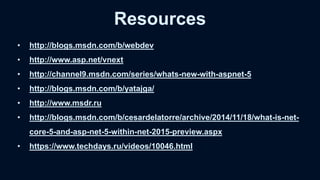Asp.net 5 cloud
- 1. ASP.NET 5 THE NEXT VERSION OF ASP.NET Karen Tazayan Microsoft ASP.NET/IIS MVP
- 2. History of ASP and ASP.NET • 1996 - Active Server Pages (ASP) • 2002 – ASP.NET 1.0 • 2003 – ASP.NET 1.1 • 2005 – ASP.NET 2.0 (Master pages, Themes, Localization and Globalization…) • 2007 – ASP.NET 3.5 (ASP.NET AJAX, LINQ, Dynamic Data) • 2009 – ASP.NET 3.5 SP1 (MVC 1) • 2010 – ASP.NET 4.0 (Web Pages, MVC 2) • 2012 – ASP.NET 4.5 (Web API, SignalR, MVC 4) • 2013 – ASP.NET 4.5.1 (One ASP.NET, MVC 5, Web API 2) • 2014 – ASP.NET 5 (The next version)
- 3. Cloud Optimized ASP.NET • Fast and lean runtime for the server • Cloud-optimized subset of the .NET Framework • Cloud-ready environment-based configuration • Ability to host on self-host in your own process • Cross-Platform Runtime (.NET Core for Windows, Linux and Mac OS X) • Fast HTTP performance (New HTTP request pipeline) • Simplified dependency management • Single aligned web stack for Web UI and Web APIs • Diagnostics (Tracing/Logging without re-deploy)
- 5. The Future of .NET and ASP.NET ?
- 10. ASP.NET 5 on the .NET Core
- 11. ASP.NET 5 Features • More Faster (Faster startup times, Lower memory, Higher density) • Totally Modular (Features and Framework as packages) • Cloud Optimized (Features are designed to work locally and in the cloud.) • Cross-Platform (Windows, Mac, Linux) • Open Source (All Open Source, https://github.com/aspnet/home/)
- 12. • http://blogs.msdn.com/b/webdev • http://www.asp.net/vnext • http://channel9.msdn.com/series/whats-new-with-aspnet-5 • http://blogs.msdn.com/b/yatajga/ • http://www.msdr.ru • http://blogs.msdn.com/b/cesardelatorre/archive/2014/11/18/what-is-net- core-5-and-asp-net-5-within-net-2015-preview.aspx • https://www.techdays.ru/videos/10046.html Resources












